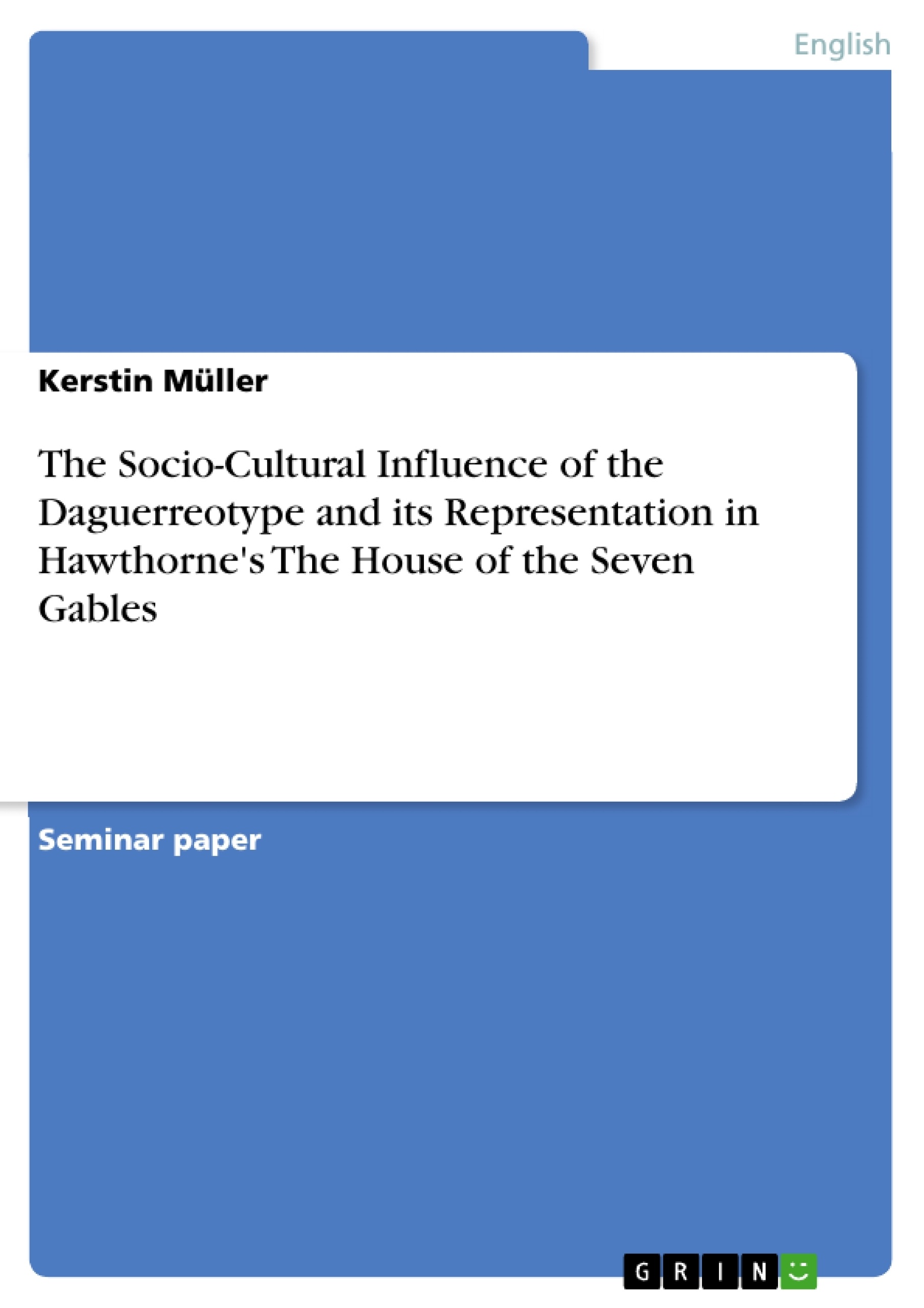The subject of this anonymous poem, published in theBoston Daily Evening Transcriptin 1850, is the daguerreotype, and early form of photography from the middle of the nineteenth century. The very fact that a technology received this form of attention, being the subject of a poem, clearly states that it was of some importance and lingered in people’s minds. The invention itself and its enormous popularity took place around the same decades that Nathaniel Hawthorne wrote and published many of his major works, includingThe House of the Seven Gables.“Etching his text with strokes of ambiguity and dubiety, Hawthorne draws widely on figural terms from the popular discourse of the daguerreotype circulating in the print culture of the 1840s and early 1850s” (Trachtenberg 33). In the course of this paper the development of the daguerreotype, its influence on the American culture and its obvious manifestation inThe House of the Seven Gablesshall be analysed. Hawthorne used the character of Holgrave, the daguerreotypist, not only to solve the old mystery surrounding the Pyncheon family, but also to point at the art’s relevance for his contemporary culture. “Sharing features of both ‘Novel’ and ‘Romance’, of science and magic, of modernity and tradition, the daguerreotype plays a strategic role in the narrative as an emblem of the ambiguity that the tale will affirm as the superior mark of ‘Romance’” (Trachtenberg 31). In the sixteenth century, thecamera obscurawas the first invention to project images onto surfaces, yet not fixing it. The only way of creating a lasting image was the art of drawing and painting. Towards the middle of the eighteenth century the invention of Louis-Jacques-Mandé Daguerre (1787-1851) revolutionized the existing world if iconography. The so-called daguerreotype marked out the possibilities and represented an entirely new perspective of portraiture. The new technique appeared first in 1839 and it was “to extend the field of representation and to wrest an important iconographical role from drawing, in particular in the area if documentation and illustration“ (Lemagny 20). Up till then, fixation and reproduction were the two large challenges. As traditional paintings were very time-consuming and costly, there were numerous attempts to use the technique of thecamera obscurain order to produce images in some sort of fixed form. [...]
Inhaltsverzeichnis (Table of Contents)
- Introduction
- The daguerreotype and its cultural rise.
- The invention
- Portraiture
- Daguerreotypy's popularization in the United States
- Portability and Celebrity Cult
- The Significance of physiognomy for the daguerreotype
- Daguerreotypy in The House of the Seven Gables
- Display of physiognomic aspects in the novel
- Hypocrisy, daguerreotypy and deception
- Relevance of Light and Sunshine
- Conclusion
Zielsetzung und Themenschwerpunkte (Objectives and Key Themes)
This paper investigates the development of the daguerreotype, its cultural influence, and its prominent manifestation in Nathaniel Hawthorne's novel "The House of the Seven Gables." It analyzes how Hawthorne utilizes the character of Holgrave, the daguerreotypist, to delve into the mystery surrounding the Pyncheon family while also highlighting the art's significance to his contemporary culture. The paper explores the interplay of "Novel" and "Romance," science and magic, modernity and tradition, and the ambiguity inherent in the daguerreotype as a symbolic embodiment of "Romance."
- The rise and cultural impact of the daguerreotype
- The role of the daguerreotype in the narrative of "The House of the Seven Gables"
- The representation of physiognomy and deception in Hawthorne's novel
- The significance of light and sunshine as themes in the context of daguerreotypy
- The relationship between the daguerreotype and the concept of "Romance" in Hawthorne's work
Zusammenfassung der Kapitel (Chapter Summaries)
The introduction explores the significance of the daguerreotype through an anonymous poem from 1850, highlighting the invention's cultural relevance. It contextualizes the daguerreotype within the same time period as Hawthorne's major works and introduces the concept of "Romance" as a key theme.
Chapter 2 focuses on the development of the daguerreotype. It traces the origins of the technique, from the camera obscura to Niépce's heliography and Daguerre's advancements. It delves into the daguerreotype's impact on portraiture, its popularity in the United States, and the cultural significance of its portability and association with celebrity culture.
Chapter 3 explores the presence of the daguerreotype in "The House of the Seven Gables." It examines the novel's portrayal of physiognomic aspects, the relationship between hypocrisy, daguerreotypy, and deception, and the thematic importance of light and sunshine.
Schlüsselwörter (Keywords)
The primary keywords and focus topics include the daguerreotype, its cultural influence, "The House of the Seven Gables," Nathaniel Hawthorne, physiognomy, deception, light, sunshine, "Romance," and portraiture.
- Quote paper
- Kerstin Müller (Author), 2006, The Socio-Cultural Influence of the Daguerreotype and its Representation in Hawthorne's The House of the Seven Gables, Munich, GRIN Verlag, https://www.grin.com/document/57926



